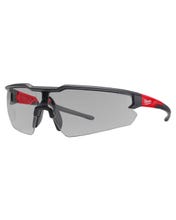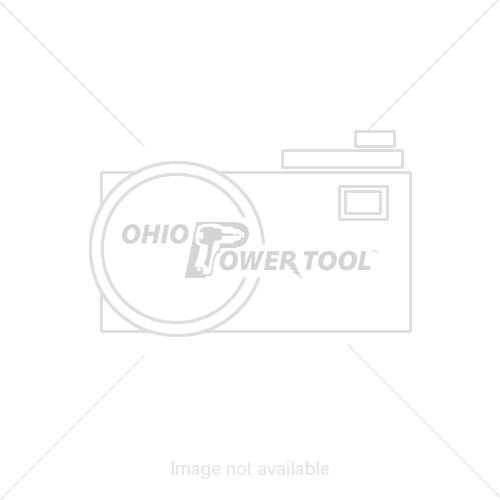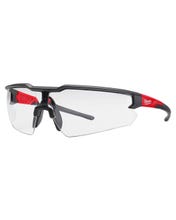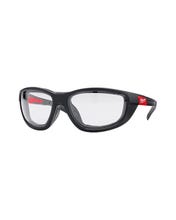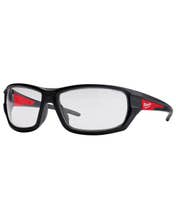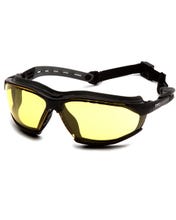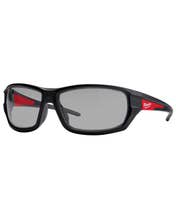Safety Glasses & Goggles

Filters >>
Narrow it Down!
Filters >>
Narrow it Down!
-
Milwaukee Safety Glasses - Clear Anti-Scratch Lenses 48-73-2010On Order This item is currently on order and expected to arrive soon, typically 2-6+ business days depending on when order was placed. We do work to update customers if long delays are expected. Please do not hesitate to call our sales team with questions or stock status.SKU: 48-73-2010$797
-
Pyramex Intruder Clear Hardcoat Lens & Temple Safety Glasses S4110SIn-Stock At least one of this item is in-stock currently. In-stock items typically ship within 1 business day, expedited orders before 1pm typically same day. Please do not hesitate to call our sales team with questions or stock status.SKU: PYRS4110S$129
-
Lift Camo Quest Safety Glasses With Amber Lens EQT-12CFABIn-Stock At least one of this item is in-stock currently. In-stock items typically ship within 1 business day, expedited orders before 1pm typically same day. Please do not hesitate to call our sales team with questions or stock status.SKU: LIFTEQT-12CFAB$571
-
Milwaukee Gray Indoor/Outdoor Anti-Scratch Safety Glasses 48-73-2106On Order This item is currently on order and expected to arrive soon, typically 2-6+ business days depending on when order was placed. We do work to update customers if long delays are expected. Please do not hesitate to call our sales team with questions or stock status.SKU: 48-73-2106$797
-
Milwaukee Safety Glasses with Magnified Clear Anti-Scratch Lenses +1.00 Magnification - Polybag Packaging 48-73-2201In-Stock At least one of this item is in-stock currently. In-stock items typically ship within 1 business day, expedited orders before 1pm typically same day. Please do not hesitate to call our sales team with questions or stock status.SKU: 48-73-2201$1097
-
Milwaukee Tinted Performance Fog-Free Safety Glasses 48-73-2026In-Stock At least one of this item is in-stock currently. In-stock items typically ship within 1 business day, expedited orders before 1pm typically same day. Please do not hesitate to call our sales team with questions or stock status.SKU: 48-73-2026$1997
-
Milwaukee Tinted High Performance Safety Glasses w/ Fog-Free Lenses 48-73-2025In-Stock At least one of this item is in-stock currently. In-stock items typically ship within 1 business day, expedited orders before 1pm typically same day. Please do not hesitate to call our sales team with questions or stock status.SKU: 48-73-2025$1997
-
Pyramex Intruder Readers +2.5 Clear Lens Safety Glasses S4110R25In-Stock At least one of this item is in-stock currently. In-stock items typically ship within 1 business day, expedited orders before 1pm typically same day. Please do not hesitate to call our sales team with questions or stock status.SKU: PYRS4110R25$309
-
Pyramex PMXTREME Gray Anti-Fog Lens with Black Frame and Cord SB6320STPIn-Stock At least one of this item is in-stock currently. In-stock items typically ship within 1 business day, expedited orders before 1pm typically same day. Please do not hesitate to call our sales team with questions or stock status.SKU: PYRSB6320STP$309
-
Milwaukee Tinted Fog-Free Anti-Scratch Safety Glasses 48-73-2018In-Stock At least one of this item is in-stock currently. In-stock items typically ship within 1 business day, expedited orders before 1pm typically same day. Please do not hesitate to call our sales team with questions or stock status.SKU: 48-73-2018$1497
-
Milwaukee Yellow Fog-Free Performance Safety Glasses 48-73-2121In-Stock At least one of this item is in-stock currently. In-stock items typically ship within 1 business day, expedited orders before 1pm typically same day. Please do not hesitate to call our sales team with questions or stock status.SKU: 48-73-2121$1997
-
Milwaukee Safety Glasses - Tinted Anti-Scratch Lenses 48-73-2015Available to Order This item is currently not on order and typically would expect 4-12+ days to receive in but can be longer. We do work to update customers if long delays are expected. Please do not hesitate to call our sales team with questions or stock status.SKU: 48-73-2015$797
-
Pyramex Intruder Grey Hardcoat Lens & Temple Safety Glasses S4120SIn-Stock At least one of this item is in-stock currently. In-stock items typically ship within 1 business day, expedited orders before 1pm typically same day. Please do not hesitate to call our sales team with questions or stock status.SKU: PYRS4120S$129
-
Milwaukee Clear Performance Fog-Free Safety Glasses 48-73-2021In-Stock At least one of this item is in-stock currently. In-stock items typically ship within 1 business day, expedited orders before 1pm typically same day. Please do not hesitate to call our sales team with questions or stock status.SKU: 48-73-2021$1997
-
Pyramex Clear Clear-Hardcoated Anti-Fog Intruder Safety Glasses S4110STIn-Stock At least one of this item is in-stock currently. In-stock items typically ship within 1 business day, expedited orders before 1pm typically same day. Please do not hesitate to call our sales team with questions or stock status.SKU: PYRS4110ST$159
-
Pyramex Intruder Indoor/Outdoor Mirror Lens Safety Glasses S4180SIn-Stock At least one of this item is in-stock currently. In-stock items typically ship within 1 business day, expedited orders before 1pm typically same day. Please do not hesitate to call our sales team with questions or stock status.SKU: PYRS4180S$219
-
Pyramex Safety Glasses Side Shields Clear SS100In-Stock At least one of this item is in-stock currently. In-stock items typically ship within 1 business day, expedited orders before 1pm typically same day. Please do not hesitate to call our sales team with questions or stock status.SKU: PYRSS100$299
-
Milwaukee Safety Glasses with Magnified Clear Anti-Scratch Lenses +2.50 Magnification - Polybag Packaging 48-73-2207In-Stock At least one of this item is in-stock currently. In-stock items typically ship within 1 business day, expedited orders before 1pm typically same day. Please do not hesitate to call our sales team with questions or stock status.SKU: 48-73-2207$1097
-
Milwaukee Tool Tinted Safety Glasses 48-73-2005In-Stock At least one of this item is in-stock currently. In-stock items typically ship within 1 business day, expedited orders before 1pm typically same day. Please do not hesitate to call our sales team with questions or stock status.SKU: 48-73-2005$697
-
Milwaukee Clear Anti-Scratch Safety Glasses 48-73-2011In-Stock At least one of this item is in-stock currently. In-stock items typically ship within 1 business day, expedited orders before 1pm typically same day. Please do not hesitate to call our sales team with questions or stock status.SKU: 48-73-2011$797
-
Pyramex Capstone Gray Direct/Indirect Goggle with Clear Anti-Fog Lens GG504TIn-Stock At least one of this item is in-stock currently. In-stock items typically ship within 1 business day, expedited orders before 1pm typically same day. Please do not hesitate to call our sales team with questions or stock status.SKU: PYRGG504T$979
-
Pyramex ZTEK Gray +2.5 Reader Lens with Gray Temples S2520R25In-Stock At least one of this item is in-stock currently. In-stock items typically ship within 1 business day, expedited orders before 1pm typically same day. Please do not hesitate to call our sales team with questions or stock status.SKU: PYRS2520R25Was $769$654
-
Pyramex Velar Safety Glasses w/ Mirror Blue Lens SB10465DIn-Stock At least one of this item is in-stock currently. In-stock items typically ship within 1 business day, expedited orders before 1pm typically same day. Please do not hesitate to call our sales team with questions or stock status.SKU: PYRSB10465D$849
-
Pyramex Ever-Lite Clear H2MAX Anti-Fog Lens with Black Frame SB8610DTMIn-Stock At least one of this item is in-stock currently. In-stock items typically ship within 1 business day, expedited orders before 1pm typically same day. Please do not hesitate to call our sales team with questions or stock status.SKU: PYRSB8610DTM$579
-
Pyramex Proximity Dark Gray H2MAX Anti-Fog Lens Black Frame SB9323STMIn-Stock At least one of this item is in-stock currently. In-stock items typically ship within 1 business day, expedited orders before 1pm typically same day. Please do not hesitate to call our sales team with questions or stock status.SKU: PYRSB9323STM$749
-
Milwaukee Clear Performance Fog-Free Safety Glasses with Gaskets 48-73-2041In-Stock At least one of this item is in-stock currently. In-stock items typically ship within 1 business day, expedited orders before 1pm typically same day. Please do not hesitate to call our sales team with questions or stock status.SKU: 48-73-2041$2997
-
Milwaukee Gray Indoor/Outdoor Fog-Free Performance Safety Glasses 48-73-2126In-Stock At least one of this item is in-stock currently. In-stock items typically ship within 1 business day, expedited orders before 1pm typically same day. Please do not hesitate to call our sales team with questions or stock status.SKU: 48-73-2126$1997
-
Pyramex Clear +2.0 H2X Anti-Fog XSG Reader Lens With Black Strap/Temples GB4010STR20In-Stock At least one of this item is in-stock currently. In-stock items typically ship within 1 business day, expedited orders before 1pm typically same day. Please do not hesitate to call our sales team with questions or stock status.SKU: PYRGB4010STR20Was $1009$807
-
Pyramex Capstone Clear Anti-Fog Dual Lens w/ Clear Shield GG504DTSHIELDIn-Stock At least one of this item is in-stock currently. In-stock items typically ship within 1 business day, expedited orders before 1pm typically same day. Please do not hesitate to call our sales team with questions or stock status.SKU: PYRGG504DTSHIELD$2469
-
Milwaukee Clear High Performance Safety Glasses w/ Fog-Free Lenses 48-73-2020In-Stock At least one of this item is in-stock currently. In-stock items typically ship within 1 business day, expedited orders before 1pm typically same day. Please do not hesitate to call our sales team with questions or stock status.SKU: 48-73-2020$1997
-
Milwaukee Gray Indoor/Outdoor Fog-Free Anti-Scratch Safety Glasses 48-73-2108In-Stock At least one of this item is in-stock currently. In-stock items typically ship within 1 business day, expedited orders before 1pm typically same day. Please do not hesitate to call our sales team with questions or stock status.SKU: 48-73-2108$1497
-
Milwaukee Safety Glasses with Magnified Clear Anti-Scratch Lenses +3.00 Magnification - Polybag Packaging 48-73-2209In-Stock At least one of this item is in-stock currently. In-stock items typically ship within 1 business day, expedited orders before 1pm typically same day. Please do not hesitate to call our sales team with questions or stock status.SKU: 48-73-2209$1097
-
Milwaukee Polarized High Performance Safety Glasses w/ Gasket & Fog-Free Lenses 48-73-2045In-Stock At least one of this item is in-stock currently. In-stock items typically ship within 1 business day, expedited orders before 1pm typically same day. Please do not hesitate to call our sales team with questions or stock status.SKU: 48-73-2045$3997
-
Milwaukee Yellow Fog-Free Anti-Scratch Safety Glasses 48-73-2103In-Stock At least one of this item is in-stock currently. In-stock items typically ship within 1 business day, expedited orders before 1pm typically same day. Please do not hesitate to call our sales team with questions or stock status.SKU: 48-73-2103$1497
-
Pyramex Isotope Amber H2MAX Anti-Fog Lens with Black Frame GB9430STMAvailable to Order This item is currently not on order and typically would expect 4-12+ days to receive in but can be longer. We do work to update customers if long delays are expected. Please do not hesitate to call our sales team with questions or stock status.SKU: PYRGB9430STM$1269
-
Pyramex Emerge Black 5.0 IR Filter Welding Glasses SB7950SFIn-Stock At least one of this item is in-stock currently. In-stock items typically ship within 1 business day, expedited orders before 1pm typically same day. Please do not hesitate to call our sales team with questions or stock status.SKU: PYRSB7950SF$879
-
Milwaukee Tinted Polarized Performance Fog-Free Safety Glasses with Gaskets 48-73-2046In-Stock At least one of this item is in-stock currently. In-stock items typically ship within 1 business day, expedited orders before 1pm typically same day. Please do not hesitate to call our sales team with questions or stock status.SKU: 48-73-2046$3997
-
Milwaukee Gray High Performance Safety Glasses w/ Fog-Free Lenses 48-73-2125In-Stock At least one of this item is in-stock currently. In-stock items typically ship within 1 business day, expedited orders before 1pm typically same day. Please do not hesitate to call our sales team with questions or stock status.SKU: 48-73-2125$1997
-
Milwaukee Tinted Anti-Scratch Safety Glasses 48-73-2016In-Stock At least one of this item is in-stock currently. In-stock items typically ship within 1 business day, expedited orders before 1pm typically same day. Please do not hesitate to call our sales team with questions or stock status.SKU: 48-73-2016$797
-
Milwaukee Safety Glasses with Magnified Clear Anti-Scratch Lenses +2.00 Magnification - Polybag Packaging 48-73-2205In-Stock At least one of this item is in-stock currently. In-stock items typically ship within 1 business day, expedited orders before 1pm typically same day. Please do not hesitate to call our sales team with questions or stock status.SKU: 48-73-2205$1097
-
Milwaukee Safety Glasses - +3.00 Magnified Clear Anti-Scratch Lenses 48-73-2208Available to Order This item is currently not on order and typically would expect 4-12+ days to receive in but can be longer. We do work to update customers if long delays are expected. Please do not hesitate to call our sales team with questions or stock status.SKU: 48-73-2208$1097
-
Pyramex ZTEK Gray +1.5 Reader Lens with Gray Temples S2520R15In-Stock At least one of this item is in-stock currently. In-stock items typically ship within 1 business day, expedited orders before 1pm typically same day. Please do not hesitate to call our sales team with questions or stock status.SKU: PYRS2520R15Was $609$396
-
Pyramex PMXTREME Readers 2.5 Clear Lens with Black Frame and Cord SB6310SPR25In-Stock At least one of this item is in-stock currently. In-stock items typically ship within 1 business day, expedited orders before 1pm typically same day. Please do not hesitate to call our sales team with questions or stock status.SKU: PYRSB6310SPR25Was $739$443
-
Pyramex Venture Gear Tactical Overwatch Gray Anti-Fog Lens with Black Frame VGSB722TIn-Stock At least one of this item is in-stock currently. In-stock items typically ship within 1 business day, expedited orders before 1pm typically same day. Please do not hesitate to call our sales team with questions or stock status.SKU: PYRVGSB722TWas $1929$1736
-
Milwaukee Clear Anti-Scratch Safety Glasses (3 Pack) 48-73-2052In-Stock At least one of this item is in-stock currently. In-stock items typically ship within 1 business day, expedited orders before 1pm typically same day. Please do not hesitate to call our sales team with questions or stock status.SKU: 48-73-2052$2197
-
Pyramex Clear H2MAX Anti-Fog Lens with Rubber Gasket S9910STMRGIn-Stock At least one of this item is in-stock currently. In-stock items typically ship within 1 business day, expedited orders before 1pm typically same day. Please do not hesitate to call our sales team with questions or stock status.SKU: PYRS9910STMRG$1099
-
Brass Knuckle Clear Lens N-FOG Flex Glasses With Orange Frame BKFLEX-4040NIn-Stock At least one of this item is in-stock currently. In-stock items typically ship within 1 business day, expedited orders before 1pm typically same day. Please do not hesitate to call our sales team with questions or stock status.SKU: BKN-BKFLEX-4040N$439
-
Kleenguard V30 Nemesis Clear, Anti-Fog Safety Glasses (Jackson Safety) 25679In-Stock At least one of this item is in-stock currently. In-stock items typically ship within 1 business day, expedited orders before 1pm typically same day. Please do not hesitate to call our sales team with questions or stock status.SKU: 412-25679$559
Construction sites are full of potential hazards for the eyes. From flying debris and dust particles to splashes of chemicals or liquids, proper eye protection is crucial. Here's a breakdown of the key differences between safety glasses and safety goggles to help you choose the right option for keeping your eyes safe:
Design and Coverage: Safety glasses resemble standard eyeglasses but with sturdier frames and impact-resistant lenses. They typically offer protection for the front and sides of the eyes, leaving the top and bottom somewhat exposed. Safety goggles, on the other hand, boast a more comprehensive design. They consist of a fully enclosed eye cup made of plastic or rubber, with impact-resistant lenses providing 360-degree protection for the eyes. Some goggles even feature ventilation systems to prevent fogging.
Protection Level and Applications: Safety glasses are ideal for tasks with moderate eye hazards. Their lightweight design ensures comfort for extended wear and allows for good peripheral vision. They are suitable for activities like grinding metal, using power tools that generate dust, or working in environments with airborne particles. Safety goggles, however, offer superior protection against a wider range of hazards. They are the go-to choice for tasks involving splashes of liquids or chemicals, working in dusty environments with high particle concentrations, or situations with a risk of flying debris or objects bouncing off surfaces (e.g., hammering, bricklaying).
Comfort and Considerations: Safety glasses generally provide a more comfortable wear due to their lighter weight and open design. However, this openness can leave the eyes vulnerable to certain hazards. Safety goggles, while offering superior protection, can sometimes feel bulky or restrict peripheral vision. Some models address these concerns with lightweight materials and ventilation systems. When choosing between safety glasses and goggles, prioritize the specific hazards present on the jobsite and the level of protection required.
By understanding the strengths and limitations of both safety glasses and safety goggles, construction workers in Ohio can make informed decisions to safeguard their most valuable asset – their vision – and avoid potential eye injuries on the job.






